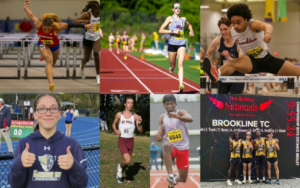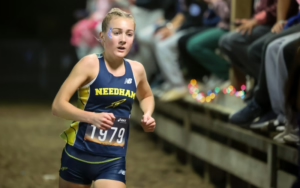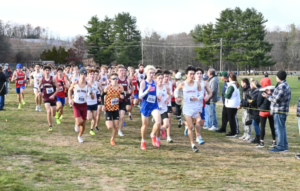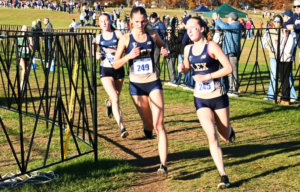The Boston Marathon has experienced just about everything in its long history. With its mid-April date, the elements can always play a factor with extreme heat some years, frigidly cold and/or rainy conditions during other years. Then, of course, there was the terrorist bombing, which this Monday’s race will be the tenth anniversary of that horrific and senseless attack on the oldest and most prestigious footrace in the world.
For North Andover’s John Gorman, if anything’s happened within the last four decades at Boston, chances are he was part of it. That’s because the 65-year-old marathoner has pretty much made the 26.2-mile race an annual tradition from the time he ran his first back in 1981. Since that race, Gorman has finished 34 Boston Marathons, including 23 straight with Monday’s 127th edition of the storied race.
Gorman, a 1976 grad of Saint Raphael Academy in Pawtucket, R.I., where he starred in track and cross country, got inspired to eventually attempt the grueling distance in what might be described as typical of a diehard distance runner.
“The assistant coach (at St. Ray’s) for cross country and track was Brother William Wynne. He ran Boston, I think, all four years I was there,” Gorman said.”I remember we used to have our track workouts at the McCoy Stadium annex. I always remember him. He was always at practice after the marathon that he ran. I remember he always looked like a mess. That kind of inspired me a little bit.”
Gorman endured moderate success for the Saints, earning All-Valley honors in cross country. He didn’t compete in college while attending the University of Rhode Island. But a little less tan a year after graduating from URI in 1980, found himself at the starting line of Boston competing in his first marathon.
“After URI, I hadn’t really been running serious all four years,” he said. “I was starting to gain some weight and I was like, ‘You know what, I need to try and lose weight. I remember running the Seekonk (5M) Road Race (in November). I did all right, but was still 20 pounds too heavy. I started up again in January and decided to jump into the marathon to see what I can do.”
Running the race unofficially as a bandit, Gorman finished the trek from Hopkinton to Copley Square in 2 hours, 55 minutes. Seven months later, he clocked an official 2:37 at the now-defunct Ocean State Marathon in Newport, R.I.
“The rest is history, I guess,” he said.
Gorman recalls his first time at Boston as a better experience as most with the marathon. He remembers never experiencing “the wall” that most first-timers or even veterans hit in the late stages. The dreaded four-mile stretch from mile 17 to 21, an uphill climb commonly referred to as Heartbreak Hill, never really affected his overall pace.
“I felt great,” he said. “I just remember running along and looking around and seeing all these people with (bib) numbers that weren’t too high, decent runners. I just remember hearing all about Heartbreak Hill. I got up to one point where there’s a sign that says it’s all downhill from here. I was like, ‘What?.’ I thought i was going to have to climb a Mount Washington-type hill. I was like, ‘This isn’t that bad.’ I finished. I was sore like marathons usually are after running them. It was nothing really bad. I thought it was great. There was decent weather. It was a good experience.”
Gorman, a veteran of 50 marathons, has a PR of 2:28.01, which he did at the 1983 Ocean State Marathon. He ran 2:28 on two other occasions, too. He was timed in 2:28.11 in ‘82 at Ocean State and also ran 2:28.30 at the Sri Chinmoy Marathon that winter at Hampton Beach in New Hampshire.

It was also during this time that Gorman hooked up with the the old Johnson & Wales Athletic Club, an elite, Rhode Island-based running club that featured some of the region’s best runners and marathoners, such as seven-time Ocean State Marathon winner Bobby Doyle, and two-time OSM champion Tom Grundy. Among other notable members that made their marks for JWAC was Coventry’s Rolande Davide, Warwick’s Mark Skinkle, Cumberland’s Tom and Bob Ratcliffe, and Ron and Pat Gillooly, Foxboro’s Wally Collins and a number of others. Most of the ‘A’ team were sub 2:20 guys with Doyle and Tom Ratcliffe both running bests in the 2:14 range.
Some of the JWAC members, including the Ratcliffes, Gilloolys and Collins, later moved into a house off of River Street in West Newton in the early 1980s where they lived and trained together. Some of the other runners that lived at one point at the house were former Providence College All American Mick O’Shea, Vin Fleming, who was fifth at Boston in 1977, and Pete Pfitzinger, the winner of the U.S. Olympic Marathon Trials in 1984.
In November of ‘84, Ron Gillooly offered an invite to Gorman to move into the often-crowded, two-story house, one that had as many as 10 people residing at any given time, most with the same common goal in mind of developing into top-class, high-level athletes on the local and national running circuit.
“I was living with my sister in Pawtucket at the time,” he said. “I was thinking anything is better than this. There were like eight bedrooms and we had like 10 people there. Ron’s like, ‘I think you’re going to have to live in the basement.’ There was a mattress and an old bureau. It was a pretty ugly sight.”
With the talent that occupied the household, Gorman joked, “I always tell people, I just ran 2:28 and I moved in and automatically became the slowest runner.”
At the time he was living in the house, Gorman was employed at New Balance where he worked in promotions and customer service. Among one of his co-workers was Pfitzinger. He recalled the time the marathoner won the Trials by upsetting the favored Alberto Salazar in the closing stages of the race. He also talked about the impromptu road trip to Buffalo, N.Y., that was planned at the Eliot Lounge in Boston on the eve of the race to watch Pfitzinger as well as Tom Ratcliffe compete at the Trials.

“We are all sitting at the Elliot and it’s me, (housemate) Dan (Grundy), Michael Ryan and I think, Pat Gillooly,” he said. “It’s like 11:30 at the Elliott the night before the Trials. We’re all looking at each other and saying, ‘Pete and Tommy are out doing the Olympic Trials and here we are.’ I don’t know who said it, but we’re like let’s go see them. It’s an eight-hour drive. We’re like, “Who’s going to drive?’ I had this old Mercury Capri. I said, ‘I’ll take my car.’ We went to the Bay Bank machine and pulled out cash and all hopped in the Capri and went to Buffalo. We got there about 11-11:30. We then waited around for the Trials to begin. It was so exciting when Pete won. He was so far ahead during the race. But right near the end, he got passed and it looked like he was done. He then came on the last 200 yards, sprinted and out-kicked Salazar. You wouldn’t believe how exciting that was for me. I was working with Pete at the time. I was like, ‘I’m living with an Olympic marathoner. The best marathoner in the country.’ It was pretty exciting.”
While training and racing was taken seriously, the group at River Street also liked to have a little fun, especially Gorman.
“One of the funniest stories is one morning I’m eating breakfast and was having an omelet. I said to Ron, ‘You know what, I can eat like 10 of these.’ Ron’s like, ‘Nah, you couldn’t.’ I’m like, ‘Yeah, I think I could.’ So the challenge was on,” Gorman said. “The next Saturday morning, Ron and Tom cooked like 10 three-egg omelets. After the fourth or fifth, I’m like, ‘What did I get myself into?’ I think I made it to 9 ½ omelets, and I threw up.”
Throughout his long running career, Gorman has endured a number of serious health issues. Demonstrating the will that’s so common among marathoners, he always seem to persevere. Gorman overcame prostate cancer in the early 2000s, two bouts of Lyme disease and a broken ankle at the age of 32.
“That was probably the hardest one of them all,” he said.
Gorman suffered his broken ankle in October of 1991 while hiking up Mount Kearsarge in New Hampshire with his wife and a group of friends.. It was an injury that required 11 screws and plates to repair and one that his doctor gave him a grim report on his future as a marathoner.
“We’re on top of Mount Kearsarge and coming down it was like a wet day,” he said. “I just took a wrong step and I could hear a crack. We’re on top of the mountain and I could feel the break, feel where it separated. I said to my wife, ‘I think I broke my leg.’ The fire department had to hike all the way up and carry me on a stretcher all the way down Mount Kearsarge.”
“The doctors told me that my career was done,” he added. “They said they would not recommend continuing to run. that I could get get arthritis in my ankle later in my older years and would not recommend to keep running. But then I had others tell me it’s okay and that running is good and it helps prevent arthritis.”
The second opinion proved to be right.
In fact, just six months after the injury, Gorman was back on the starting line of Boston and, considering the circumstances, finished the race in a very respectable 3:20.
“I got the cast off around Thanksgiving and pretty much did physical therapy on my own by stretching,” he said. “I just stretched and stretched to get the flexibility back and started running and training again in January. I knew I wasn’t going to be setting any records. I ended up running and I finished. The following July, I had the screws taken out, which made it more comfortable to run.”
Gorman, who was also a member of Whirlaway Racing Team, has certainly experienced a lot in his long history at Boston He was among the field that competed in the 2018 race that was held under a steady downpour and was won on the women’s side by Desi Linden, who ended a 33-year-old drought by Americans.
“I did okay,” he said. “The pre-race was a challenge. You’re like walking around in the rain. Athletes Village was like one big mudfest. It was like Woodstock. Your feet are getting muddy. Once you got going, it wasn’t bad. The funny thing is as I was running along my Garmin watch stopped so I didn’t know what I was running. All I was thinking was I am not going to qualify. I didn’t go all out. I was probably like 85 percent. I got to the finish and I missed qualifying by a minute. The worst (race)was 2012 when it was 85-86 degrees. That was worse than the torrential downpours.”
In that race, Gorman came across the line between 3:22-3:23.
“I really wanted to, probably for the last time, break three hours,” he said. “I was in really, really good shape. That was the year I could break it or really come close. I remember looking at my time and thinking that it wasn’t too good and then looking at people I usually run with comparable to my time and they were like 3:45 to four hours. I did pretty good compared to my friends.”
The following April in 2013 was the year of the terrorist bombing when brothers Dzhokhar and Tamerian Tsarnaev planted two homemade pressure-cooker bombs near the finish line of the race that exploded and killed three people and injured hundreds of others.
“I had already finished at like 3:17 or something like that,” Gorman said. “I went back to the Fairmont Copley Hotel. The Whirlaway Team had a room there so I showered and I was walking down Huntington Avenue near Exeter Street and I was supposed to meet my friend at Copley Hotel at the Champions Bar up top. I’m standing there going across the street and all of a sudden I hear the explosion. I thought it was a transformer. Everyone is kind of wondering what happened and then 30 seconds later another explosion. All of a sudden, all hell broke loose, cops were out directing traffic and looked like they were in a panic, taking different steps that I’m sure they were told to do for a terrorist attack. Maybe two minutes later, I looked down Exeter Street, down at Boylston (Street), and there must have been like 100 people running down the street. It looked like they were running for their lives. I called my friend John, who was up at the bar and told him there had been a terrorist attack and that we had to go. He thought I was kidding.”

Save for a few where he got a bib number by a waiver from his running club, Gorman has made the qualifying standard for nearly all of his races at Boston. His last time breaking the three-hour barrier was in 2001, which was the beginning of his current streak.
“It was the first time I ran Boston since 1997,” he said. “In 1997, I ran 2:38. That was before I just turned 40. I remember (in 2001) going out and I was running 2:40 pace and ended up running 2:53. I crashed and burned. I came close a few times after that, like 3:06, 3:10, 3;11 and 3:03, which i did mostly in my fifties.”
Gorman doesn’t necessarily have a time goal for this Monday’s race.
“My goal is just to finish,” he said. “I qualified last year by 19 seconds. I ran 4:04.41 or something like that. I slowed down a lot over the past year. I always feel like I wouldn’t be able to do it again. If I finish, and feel good, feel half decent about it for next year, I might raise money for charity and get the number that way. I would like to get 25 in a row and be on the Quarter Century Club.”
As a member of the Quarter Century Club, Gorman would no longer have to worry about qualifying for Boston. Runners that compete in 25 straight races, get an automatic invite for life. Right now, there’s just about 100 members.
No doubt, running Boston, the granddaddy of all marathons, ranks right up there as one of Gorman’s favorite times of the year.
“It’s the best race in the world and it’s right in our backyard,” he said. “I really enjoy my kids growing up and seeing me run. The same spot, mile 16. The training is grueling. It sucks in the winter. It’s such a great tradition to be in the World Series of running, especially here in New England every year. To still be doing it at my age makes me happy. It’s a nice legacy for my children and grandchildren. The crowds on the street, it’s the Cadillac of all marathons. They’re everywhere you go. Every marathoner should get a chance to experience it. There’s nothing like it in the world.”











